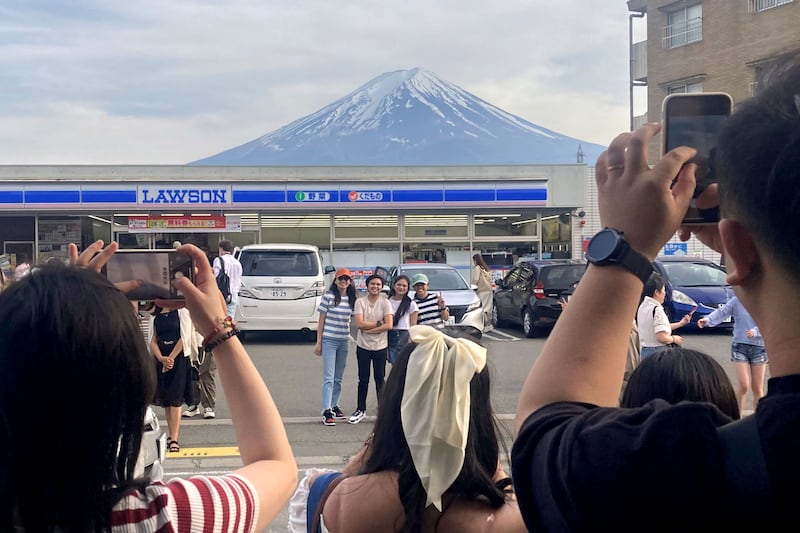I’m stood on one side of a screen while a geisha plucks the strings of a shamisen (traditional guitar) beside me. Should I emerge using a tiger pose, maybe draw for a sword like a samurai, or pretend to hold a walking stick like an old lady? I’m playing a game of ‘rock, paper, scissors’ Japanese-style in a restaurant in Kyoto.
I drop to my knees and opt for the tiger. Masana, a maiko (or apprentice geisha) appears from the other side of the screen in the form of a samurai and I lose. It’s not all bad, I think to myself, as the kimono-clad trainee serves me another glass of beer.
Normally, a chance to meet a geisha is given on an invite-only basis to elite businessmen, but I’m getting a glimpse of centuries-old fun, thanks to GetYourGuide. Their Maiko experience, available once a month for groups of up to eight people (£324pp), includes a tour of a Shinto shrine and an evening of song, dance and local delicacies.

Kyoto is at the beating heart of Japanese culture. Since the country re-opened its doors to foreign visitors in late 2022, it’s tipped to be a popular spot. GetYourGuide has already seen a 59% rise in bookings for activities in the city compared to 2019, and have launched a new Originals series of experiences as a result.
Their one-of-a-kind offerings are designed to respectfully immerse travellers in local cultures, while sustaining and preserving traditions. And there’s no better city than Kyoto for a more traditional take on the Japanese way of life.
I arrive in Japan via Osaka, the country’s second city. During an hour-long drive to Kyoto, large industrial buildings give way to traditional wooden homes, as I enter a city that takes things a little slower than its neighbours.

My first taste of Kyoto comes at Gion Saryo, a bright and airy breakfast spot away from the main drag, which serves one of the country’s biggest obsessions: matcha. You only have to walk a few metres to see matcha drinks in vending machines or matcha flavoured ice creams served from parlours.
I’m going for the matcha bread (¥1650/£9), baked in-house using a vivid green dough. The tea house’s signature dish is a favourite with locals in the know and limited to 20 servings per day. It’s the perfect introduction to local cuisine.
My taste tour continues with a sit-down meal at Kifune Nakayoshi, a riverside restaurant north of the city, where wooden homes make way for winding roads and tree-covered hills.
Here, a place at the table means sitting cross-legged on a platform perfectly perched over the water. Instead of the din of diners and cutlery, it’s the gentle crashing of water below that provides the soundscape to my meal (mains around ¥9,800/£53).

The next morning, I make my way to the remote village of Ohara to learn about Noh, a type of theatrical dance dating back to the 14th century.
Noh Master Shigeki welcomes me to his home, where his love for the art is plain to see. Almost half of the building is dedicated to his very own Noh studio, and I’ve been invited to get up close to hundred-year-old silk kimonos and even older masks. The detail and colours are beautiful.
I’m treated to a demonstration of the slow and careful choreography before I attempt to recreate the controlled movements myself – an opportunity that’s usually reserved for Noh apprentices.
I take off my shoes and pull on a pair of special tabi socks. It takes a lot more concentration than I expect but, in this setting, surrounded by shoji (sliding paper screens) and beautifully maintained gardens, I’m in the perfect place to focus all my efforts on learning the basics of this uniquely Japanese art.

We finish the visit with an opportunity to ask Shigeki questions, while enjoying rice-based sweets and green tea. It’s clear he takes pride in his country’s traditions and opening his home to small groups is part of his mission to share the traditions with new audiences. The Noh experience costs £110pp for groups up to six people, and takes place once a month.
Alongside these special edition tours, GetYourGuide also offers regular, more frequently held activities. I head to Arashiyama in the west of the city and its famous bamboo forest. The attraction has its fair share of tourists, but thankfully, it’s possible to avoid the crowds with a rickshaw tour (starting from £44pp).
It’s difficult not to feel like you’re getting VIP treatment while being carted from temple to trail and leaving wandering tourists behind.
My guide points to his favourite restaurants along the way before taking a break at a secluded pit stop.
“Can you see that down there?”
He points to a large frog on a lily-pad watching the world go by, while a heron perches on a nearby tree.

I get back on the rickshaw and weave through the crowds once more, before ending up at the most striking section of the route. My guide asks for my phone and captures me surrounded by the towering bamboo. Something tells me he knows all the best angles and has done for some time.
My final day starts early with before-opening access to the 1,300-year-old Ninna-Ji temple in Ukyo to the west of Kyoto. GetYourGuide’s out-of-hours access to the UNESCO-listed temple (£273pp) is available once a month and is limited to six people at a time.
A young monk, Takashi, greets us at the large and imposing gates long before the crowds start to gather. The grounds look like a stereotypical Japanese scene: painted paper screens, buildings perched on stilts, ponds filled with koi carp.
The faint smell of sandalwood incense fills the air and creates a sense of calm as we tread the boards between buildings. Selina, my translator, explains: “The high priest finished his morning prayers a few moments ago. That’s the incense he used that you’re smelling.”

Our first stop is the main hall, never before opened to the public. I must be among the first westerners given permission to step inside. Takashi takes us behind an altar-style fixture to see 400-year-old paintings depicting Buddha in various forms.
I continue my tour with a masterclass in making wagashi. The Japanese sweets are as easy on the eye as they are to eat and moulded into pretty patterns with ease by my teacher, Shinya.
A few swift swipes of his simple wooden tools and the lump of ingredients take on a whole new floral form. If only I could make it look so easy.
Finally, I make my way to the temple’s tea house. I crawl through the waist-high entrance and learn that the child-size doorway is designed to make guests show humility.
I sit cross-legged inside and wait for the tea ceremony to begin. The tea master carefully wipes bowls and cups while the sound of croaking frogs fills the air.
I sip on matcha tea and take bites out of my wagashi while asking the tea master about how she honed her skills. She tells me she’s been practising the customs and techniques for 50 years and always learns something new.
For something I thought would be so formal, the experience feels incredibly secluded and relaxed. It’s the perfect analogy for my entire trip.
In a land of bullet trains and bustling cities, I expected the traditional side of Japan to be stiffer and stauncher. What I found was a warm welcome and a country keen to keep its culture alive with anyone willing to learn.
How to plan your trip
For exclusive, one-of-a-kind experiences, see Originals from GetYourGuide at getyourguide.com








